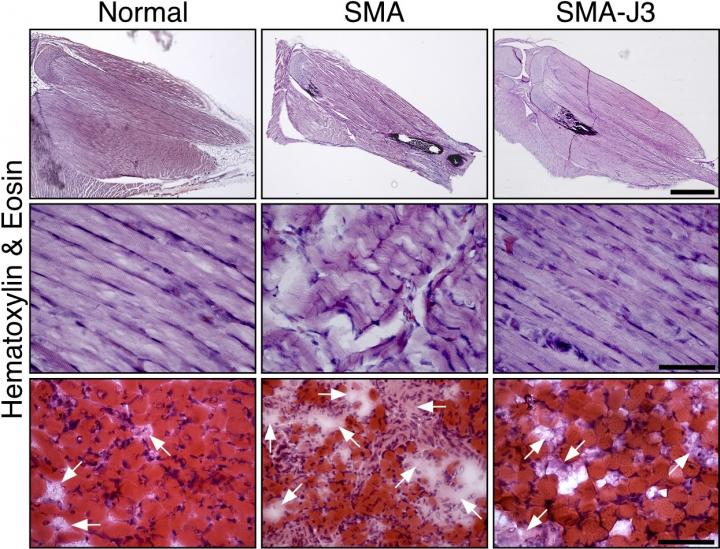Study unveils new therapeutic target for spinal muscular atrophy

From left to right: Microscopic images comparing the hind leg muscles of normal mice, mice with spinal muscular atrophy, and mice with spinal muscular atrophy that have had the enzyme JNK3 inhibited. JNK3 deficiency appears to reduce muscle degeneration (muscle-wasting) and increase muscle growth in mice with the disease. Image courtesy of the journal Human Molecular Genetics
Spinal muscular atrophy is a debilitating disease that causes weakness and wasting of the muscles. The disease ranges in severity with patients experiencing different symptoms, from the inability to sit up and stand, to trouble walking. In its severest form, the disease results in difficulty breathing and leads to death.
“We've identified the enzyme JNK3 as a therapeutic target to treat the symptoms of spinal muscular atrophy,” says Laxman Gangwani, Ph.D., an associate professor in the Center of Emphasis in Neuroscience at Texas Tech University Health Sciences Center El Paso (TTUHSC El Paso) who led the research.
In a recent study published in the December 15th issue of Human Molecular Genetics, Dr. Gangwani and his team of researchers at TTUHSC El Paso describe how mice with spinal muscular atrophy saw great improvement when the JNK3 enzyme was genetically inhibited to eliminate its activity. The finding suggests that patients with spinal muscular atrophy could also see improvement if treated with a drug that suppresses the activity of JNK3.
“We saw less muscle degeneration, more muscle growth and better muscle strength, and improvement in overall movement,” says Gangwani. “What's more striking was a four-fold reduction in initial mortality period and a two-fold increase in total lifespan.”
Spinal muscular atrophy is caused by a genetic mutation that triggers the loss of spinal cord motor neurons — neurons that help control the body's movements. As the neurons deteriorate, so does one's ability to control their own movement.
This same study, however, found that inhibiting JNK3 in mice prevented the loss of motor neurons, which is particularly important to prevent progression of disease, says Gangwani.
“So far, spinal muscular atrophy research has focused on targeting the genetic mutation to prevent degeneration of spinal motor neurons, but it hasn't been successful because of challenges associated with gene therapy,” he says. “This is the first study done that identifies a target, JNK3, that's independent of the genetic mutation of spinal muscular atrophy for novel therapeutic development.”
The TTUHSC El Paso research team now plans to test pharmacological compounds that can inhibit JNK3 in mice to identify drug compounds that will slow the progression of the disease and reduce the overall burden of this illness in patients. They've also decided to patent their idea of using a JNK3 inhibitor to treat spinal muscular atrophy.
Gangwani says, “JNK3 represents a promising new avenue of research for clinical advances in developing a treatment.”
Media Contact
All latest news from the category: Health and Medicine
This subject area encompasses research and studies in the field of human medicine.
Among the wide-ranging list of topics covered here are anesthesiology, anatomy, surgery, human genetics, hygiene and environmental medicine, internal medicine, neurology, pharmacology, physiology, urology and dental medicine.
Newest articles

Properties of new materials for microchips
… can now be measured well. Reseachers of Delft University of Technology demonstrated measuring performance properties of ultrathin silicon membranes. Making ever smaller and more powerful chips requires new ultrathin…

Floating solar’s potential
… to support sustainable development by addressing climate, water, and energy goals holistically. A new study published this week in Nature Energy raises the potential for floating solar photovoltaics (FPV)…

Skyrmions move at record speeds
… a step towards the computing of the future. An international research team led by scientists from the CNRS1 has discovered that the magnetic nanobubbles2 known as skyrmions can be…





















